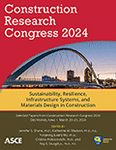Exploring Socio-Demographic Inequalities in Post-Disaster Community Well-Being: Case Study of Hurricane Harvey
Publication: Construction Research Congress 2024
ABSTRACT
Natural hazards can disrupt various aspects of the community members’ lives such as satisfaction with the solid waste management and debris removal system. These impacts can be disproportionate across communities with different socio-demographic backgrounds. This study is aimed at identifying such inequalities. To that end, a case study of the Houston area in Texas under post-Harvey situation is conducted. Satisfaction with waste and debris management services is taken as a sample metric for post-disaster well-being of community members. To quantify this metric, the 311 phone call data, which pertains to municipal service requests, is used. The dataset comprises the topic, location, and the date of municipal service requests. The number of active service requests related to waste management is taken as the metric for the related community well-being domain. Socio-demographic disparities in post-disaster community well-being of the affected zip codes are then explored. The results showed that zip codes with lower income level, more single-parent families, and multi-unit houses were affected the most by Harvey. The study outcomes can inform policymakers in identifying the zip codes that sustained disparate impacts caused by Hurricane Harvey. The proposed step-by-step method can be expanded to identify disparities with respect to other well-being domains, and for other locations.
Get full access to this article
View all available purchase options and get full access to this chapter.
REFERENCES
“311 Help and Info, City of Houston.” Available at: https://www.houstontx.gov/311/, Accessed on August 1, 2023.
Amadeo, K. (2018). “Hurricane Harvey facts, damage and costs.”.
Applied Technology, C. (2016). Critical assessment of lifeline system performance: Understanding societal needs in disaster recovery, US Department of Commerce, National Institute of Standards and Technology.
Bhattacharyya, A., Morshedi, M., and Hastak, M. (2023). “A clustering-classification approach in categorizing vulnerability of roads and bridges using public assistance big data.” International Journal of Disaster Risk Reduction, 84, 103448.
Blake, E. S., and Zelinsky, D. A. (2018). National Hurricane center tropical cyclone report: Hurricane Harvey. National Hurricane Center, National Oceanographic and Atmospheric Association.
Chakraborty, J., Collins, T. W., Montgomery, M. C., and Grineski, S. E. (2014). “Social and spatial inequities in exposure to flood risk in Miami, Florida.” Nat. Hazards Rev., 15(3), 04014006.
Christakopoulou, S., Dawson, J., and Gari, A. (2001). “The community well-being questionnaire: Theoretical context and initial assessment of its reliability and validity.” Social Indicators Research, 56(3), 319–349.
Coleman, N., Esmalian, A., and Mostafavi, A. (2020). “Equitable resilience in infrastructure systems: Empirical assessment of disparities in hardship experiences of vulnerable populations during service disruptions.” Nat. Hazards Rev., 21(4), 04020034.
Dargin, J. S., and Mostafavi, A. (2020). “Human-centric infrastructure resilience: Uncovering well-being risk disparity due to infrastructure disruptions in disasters.” PloS one, 15(6), e0234381.
Deshmukh, A., Oh, E. H., and Hastak, M. (2011). “Impact of flood damaged critical infrastructure on communities and industries.” Built Environment Project and Asset Management.
Flanagan, B. E., Gregory, E. W., Hallisey, E. J., Heitgerd, J. L., and Lewis, B. (2011). “A social vulnerability index for disaster management.” Journal of homeland security and emergency management, 8(1), 0000102202154773551792.
Flanagan, B. E., Hallisey, E. J., Adams, E., and Lavery, A. (2018). “Measuring community vulnerability to natural and anthropogenic hazards: the Centers for Disease Control and Prevention’s Social Vulnerability Index.” Journal of environmental health, 80(10), 34.
Fothergill, A., and Peek, L. A. (2004). “Poverty and disasters in the United States: A review of recent sociological findings.” Natural hazards, 32, 89–110.
Gomez, C., and Baker, J. W. (2019). “An optimization-based decision support framework for coupled pre-and post-earthquake infrastructure risk management.” Structural Safety, 77, 1–9.
Hong, B., Bonczak, B. J., Gupta, A., and Kontokosta, C. E. (2021). “Measuring inequality in community resilience to natural disasters using large-scale mobility data.” Nature communications, 12(1), 1870.
Kousky, C., Michel-Kerjan, E. O., and Raschky, P. A. (2018). “Does federal disaster assistance crowd out flood insurance?” J. Environ. Econ. Manag., 87, 150–164.
Lee, C.-C., Maron, M., and Mostafavi, A. (2022). “Community-scale big data reveals disparate impacts of the Texas winter storm of 2021 and its managed power outage.” Humanities and Social Sciences Communications, 9(1), 1–12.
Masozera, M., Bailey, M., and Kerchner, C. (2007). “Distribution of impacts of natural disasters across income groups: A case study of New Orleans.” Ecol. econ., 63(2-3), 299–306.
Oh, E. H., Deshmukh, A., and Hastak, M. (2013). “Criticality assessment of lifeline infrastructure for enhancing disaster response.” Nat. Hazards Rev., 14(2), 98–107.
Paton, D., McClure, J., and Bürgelt, P. T. (2006). “Natural hazard resilience: The role of individual and household preparedness.” Disaster resilience: An integrated approach, 105, 27.
Rufat, S., Tate, E., Burton, C. G., and Maroof, A. S. (2015). “Social vulnerability to floods: Review of case studies and implications for measurement.” International journal of disaster risk reduction, 14, 470–486.
Sirgy, M. J., Widgery, R. N., Lee, D.-J., and Grace, B. Y. (2010). “Developing a measure of community well-being based on perceptions of impact in various life domains.” Social Indicators Research, 96(2), 295–311.
Uchida, Y., Takahashi, Y., and Kawahara, K. (2014). “Changes in hedonic and eudaimonic well-being after a severe nationwide disaster: The case of the Great East Japan Earthquake.” Journal of Happiness Studies, 15, 207–221.
Wood, E., Sanders, M., and Frazier, T. (2021). “The practical use of social vulnerability indicators in disaster management.” International Journal of Disaster Risk Reduction, 63, 102464.
Information & Authors
Information
Published In
History
Published online: Mar 18, 2024
Authors
Metrics & Citations
Metrics
Citations
Download citation
If you have the appropriate software installed, you can download article citation data to the citation manager of your choice. Simply select your manager software from the list below and click Download.
